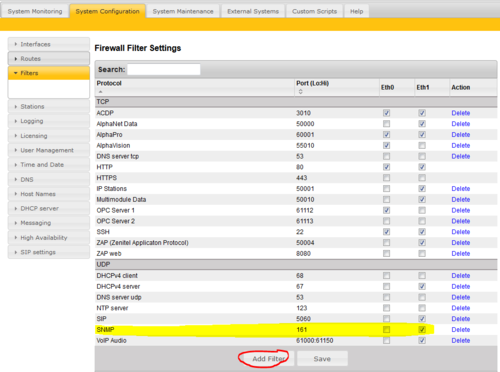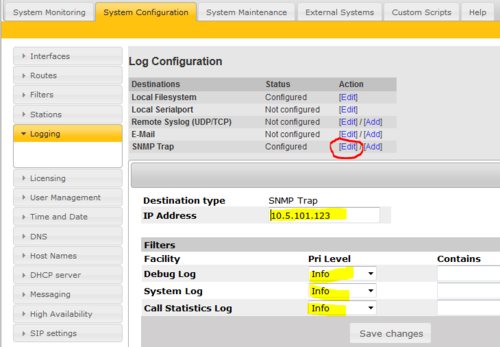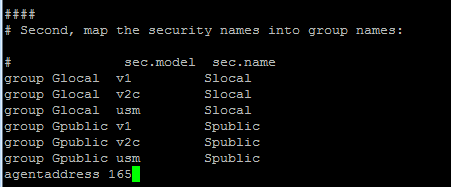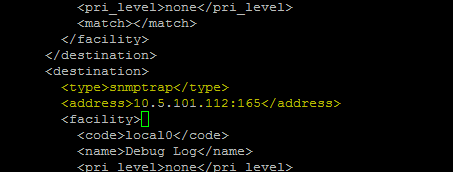Difference between revisions of "SNMP in AlphaCom XE"
From Zenitel Wiki
(→SNMP polling) |
|||
| Line 36: | Line 36: | ||
The default MIBs are always active, but in order to receive polling requests from an SNMP server you need to open the firewall (Filters) in AlphaWeb (UDP port 161). | The default MIBs are always active, but in order to receive polling requests from an SNMP server you need to open the firewall (Filters) in AlphaWeb (UDP port 161). | ||
| − | [[File:SNMP Filters 161.PNG]] | + | [[File:SNMP Filters 161.PNG|thumb|left|500px|Define and enable UDP port 161 in '''Filters''' settings in AlphaWeb]] |
| + | <br style="clear:both;" /> | ||
| + | |||
=== SNMP variables=== | === SNMP variables=== | ||
Revision as of 11:09, 24 February 2016
The AlphaCom XE runs a SNMP service, and supports SNMP polling and SNMP traps.
The main difference between a SNMP poll and a SNMP trap is which device initiates the communication. An SNMP poll is initiated by the SNMP server and the AlphaCom responds to the server. An SNMP trap is initiated by the AlphaCom when it has information to send (usually some event happened) and does not want to wait for the server to ask for information.
Contents
Stentofon MIB OID numbers
Zenitel Norway AS has assigned a Private Enterprise Number OID 26122.
The Zenitel Norway AS enterprise number is labeled enterprises.stentofon
Allocated Sub OIDs:
- 1 - enterprises.stentofon.alphacom
- 2 - enterprises.stentofon.ipstation
Note that the AlphaCom OID has of historical reasons not always followed the enterprise numbering defined above.
AlphaCom MIB
Revision 3
OID enterprises.26122: MIB text: AlphaCom MIB Revision 3
Revision 2
OID enterprises.26122: Included in RootFS versions: 0x-0xx and 1x-1xx (to be updated revision 2 released) MIB text: AlphaCom MIB Revision 2
Revision 1
OID: enterprises.9362 Included in RootFS versions: 01-0x and 10-1x (to be updated revision 2 released) MIB text: AlphaCom MIB Revision 1
SNMP polling
The default MIBs are always active, but in order to receive polling requests from an SNMP server you need to open the firewall (Filters) in AlphaWeb (UDP port 161).
SNMP variables
AMC variables from the AlphaCom MIB:
| Sensor | Object ID | Comment |
|---|---|---|
| Nodestate | 1.3.6.1.4.1.26122.1.1.1 | AMC-IP status enabled/disabled. Shows if the AlphaCom is operational. Same info as in AlphaWeb, Node State - Operational |
| RTP Statistics | 1.3.6.1.4.1.26122.1.2.1 | RTP audio statistics |
Linux variables:
| Sensor | Comment |
|---|---|
| Ping | Ping response time |
| Network interface IO | |
| Network interface eth0 | |
| Network interface eth1 | |
| IO trafic | |
| Eth1 trafic | |
| Uptime | Time since last reboot |
| CPU load | |
| Disk free | Total free disk space |
| Disk free (opt/backup) | Free space for backup |
| Disk free (opt/nvram) | Free space for the nvram |
| Disk free (/tmp) | |
| Memory: Physical memory | |
| Memory: Swap space | |
| Memory: Virtual memory | |
| SNMP Linux load average | |
| Active processes | The number of processes running in the Linux |
| Memory (Swap) Free | |
| SNMP Linux meminfo | |
| HTTP | |
| ICMP Messages In | |
| ICMP Messages Out | |
| ICMP DestUnreachable In | |
| ICMP DestUnreachable Out | |
| ICMP Errors In | |
| ICMP Errors Out | |
| TCP Segments In | |
| TCP Segments Out | |
| SNMP Messages In | |
| SNMP Messages Out | |
| UDP Datagrams In | |
| UDP Datagrams Out |
SNMP Traps
The AlphaCom logs can be sent as SNMP traps.
The alert types that support SNMP traps have a number assigned to them, for example, 1001 is the number assigned to System Log events. The following table lists the number sent in the SNMP trap for each alert type.
| Alert number | Object ID | Alert type | Alert criteria |
|---|---|---|---|
| 1001 | 1.3.6.1.4.1.26122.1.11.1001 | System log events |
|
| 1002 | 1.3.6.1.4.1.26122.1.11.1002 | Debug log events |
|
| 1003 | 1.3.6.1.4.1.26122.1.11.1003 | Call Statistics log events |
|
SNMP trap is configured in AlphaWeb, System Configuration > Logging. Select destination ‘SNMP Trap’ and configure which logs you want to send.
SNMP traps are using UDP port 162. As this is outbound data, there is no need to define this port in the Filers settings in AlphaWeb.
Frequently asked questions on SNMP
Which functions of SNMP are implemented?
In addition to the AlphaCom MIB, the standard MIBs mibII, ucd-snmp and snmpv2 are implemented. These Mibs only implements polled information.
The AlphaCom MIB implements two main statuses:
- AMC-IP status (Enabled/Disabled) (Same as AlphaWeb Node State/Operational)
- RTP statistics (Audio Statistics)
All MIBS variables are accessed through SNMP v2 protocol with community = public. All variables are read only. Example of reading the AlphaCom MIB with NET-SNMP:
> snmpwalk –v 2c –c public localhost enterprises.26122
Where to get the MIB configuration file?
The active MIB file for an AMC-IP board can be found in the folder :
/usr/local/share/snmp/mibs/ALPHACOM-MIB.txt
MIB text: AlphaCom MIB Revision 3
How to change the SNMP UDP port number?
- Connect to the linux console through the ssh port using a terminal program like Putty.
- log in as normal with alpha/com
- In the linux bash write these commands:
- su [enter]
- root password [enter]
- nano /usr/local/share/snmp/snmpd.conf
Add the line agentaddress 165 somewhere. Here 165 is the new portnumber used as an example:
- Use ctrl+X followed by Y to save and exit.
For more information see:
http://stackoverflow.com/questions/16205453/how-to-change-the-net-snmp-default-port-to-one-less-than-1024-in-linux
http://www.net-snmp.org/docs/man/snmpd.conf.html
How to change the SNMP trap UDP port number?
- Connect to the linux console through the ssh port using a terminal program like Putty.
- log in as normal with alpha/com
- In the linux bash write these commands:
- su [enter]
- root password [enter]
- nano /var/opt/www/amc_ip_config.xml [enter]
Step a couple of pages down and you should find:
<destination>
<type>snmptrap</type>
10.5.101.112
Add the new port number to the IP address like this: 10.5.101.112:165
- Use ctrl+X followed by Y to save and exit.
- Finally write:
- /etc/init.d/syslog-ng restart
For more information see:
http://www.net-snmp.org/docs/man/snmpcmd.html





